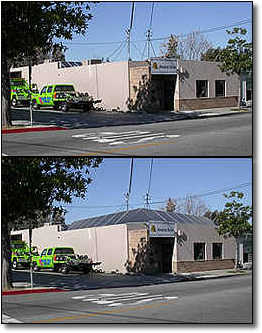California Law Shines on New Solar Energy Projects

|
by Jesse Broehl, Editor, RenewableEnergyAccess.com
October 20, 2004
The top photograph shows the three (of 18)
solar PV panels that the town of Los Gatos objected to. Akeena offered
to build a mansard roof of solar PV to improve the aesthetics. Both
parties eventually ended up in Court.
Photo: Akeena Solar
|
"To me, it was the principle. The town was just against solar
panels being visible."
- Barry Cinnamon, president of Akeena Solar
Los Gatos, California - [RenewableEnergyAccess.com]
Just in time for the solar industry's major conference in San Francisco this
week, California Governor Arnold Schwarzenegger signed a bill that will make
it less difficult for homes and businesses hoping to install solar energy
systems in towns that tend to find the projects aesthetically unfit for their
tastes.
Schwarzenegger signed AB 2473 into law, which is a strengthened Solar Rights
Act sponsored by California State Assemblywoman Lois Wolk in the 8th Assembly
District. The key improvements made to the new Solar Rights Act minimize
aesthetic solar restrictions to changes that would cost the developer no more
than US$2,000. The restrictions imposed also cannot reduce the overall system's
efficiency by any more than 20 percent. If either threshold is reached, local
authorities are no longer able to restrict the project.
In addition, the act limits building officials' review of solar installations
only to those items that relate to specific health and safety requirements of
local, state and federal law. Local authorities may still have some room to
impose restrictions, but much less than before.
"In essence, we need to remove the arbitrary imposition of unreasonable
obstacles to a homeowner or business owner's attempts to save money and reduce
our dependence on fossil fuel," Wolk said.
The political impetus for a strengthened Solar Rights Act came from a number of
situations where town administrators objected to solar energy systems on homes
or business, largely for aesthetic reasons.
"We see it all the time, not just Los Gatos, but many other
communities," said Barry Cinnamon, president of Akeena Solar, a Los
Gatos-based solar photovoltaic (PV) installation company. Cinnamon's company
became a poster child for this phenomenon when they found themselves embroiled
in the same situation two years ago.
The company applied for a building permit for a solar PV system on the roof of
its Los Gatos facility in autumn 2002. The installation was completed in
December 2002 but the town refused to approve the building permit because three
of the solar panels were visible from the street. The company appealed the
decision to the town's Planning Commission in May 2003 and to the Town Council
in August 2003; both appeals were denied.
Many homes and businesses have faced similar hurdles, and many have caved-in to
town wishes. Instead, Akeena Solar filed suit against the town.
In its suit, the company argued that the Town Council's decision violated an
earlier version of the California Solar Rights Act, which was most recently
amended by Governor Davis on September 11, 2003. Cinnamon knew it could be a
long battle, but he felt it was one worth fighting for.
"It's extraordinarily expensive to fight," Cinnamon said. "We put
on a $12,000 system, and spent $40,000 in legal fees. But to me, it was the
principle. The town was just against solar panels being visible."
Amidst the squabble, along came the strengthened Solar Rights Act in September,
just in time to turn the tide in favor of Akeena and solar fans throughout
California. Cinnamon said the town's position will be rendered irrelevant once
the law takes effect in January of 2005. The company has since settled with Los
Gatos, agreeing to pull three solar PV panels off the roof for the remainder of
the year.
"Who would have thought that it would be much quicker to change a
California law than to go through the municipal legal process?" Cinnamon
said. "And when (the bill) goes into effect in January of 2005, we and
every other solar customer in the state of California will be able to benefit
from the sun."
While the law certainly made Akeena's day a lot brighter, it will have far
reaching effects for any home or business in California. This would be
particularly important if the Schwarzenegger administration manages to pass a
comprehensive solar bill, which was a campaign promise that almost became
reality during the last legislative session. Through Schwarzenegger's prompting,
the State's Environmental Protection Agency announced its Million Solar Homes
initiative in August, 2004.
Ultimately, the measure failed to satisfy everyone's wishes. Solar thermal
advocates would have been left out entirely, a rebate funding gap would have
constrained project sizes and legislators simply didn't want consumers to pay
for the plan. However, it is very likely to come up again in some form, and
local authorities will be less of an obstacle to implementing it.
"The Governor's plans to encourage solar would be dead in the water if
municipalities continue to have free reign to restrict solar
installations," Cinnamon said.
As is often the case, California issues, and California laws are often years
ahead of other states. States like New Jersey and Pennsylvania, which have
strong incentives for solar PV systems, might soon face the same dilemma. The
rebates are even higher in New Jersey than California but the program is so new
that the rebate checks have yet to come through, according to Cinnamon, whose
company also operates an East Coast division.
"This issue hasn't even come up out there," Cinnamon said. "But
the market there is five years behind California, so they will likely need to
have a similar state law."
Copyright © 1999 - 2004 - RenewableEnergyAccess.com
Please visit www.RenewableEnergyAccess.com
for great coverage on energy today!!
